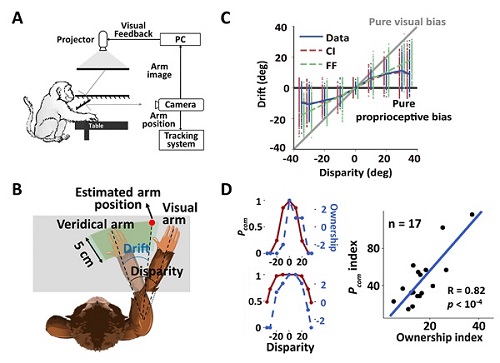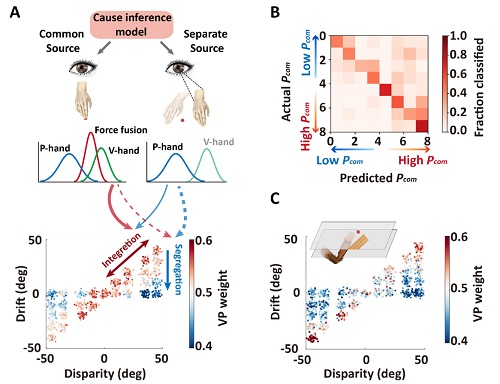Time:2019-09-10
A recent study published in
How humans and potentially other animals construct the experience of “being a self” remains one of the most intriguing questions in neuroscience. In everyday life, understanding the limits of our own body is an automatic and mostly flawless computation. Over the past years, substantial advances have been made in understanding psychological mechanisms of bodily self through experimental manipulations in humans, such as rubber-hand illusion in which arbitrary objects may be ascribed with ownership and perceived as part of the self. The perception of real and illusory hands relies on the integration of visual, tactile, and proprioceptive signals, which are governed by principles of temporal and spatial congruency. However, the neurophysiological and computational mechanisms which give rise to this illusion have been comparatively significantly less investigated and understood.
In order to explore the mechanisms of bodily self-consciousness at the neural and circuit level, the researchers designed a video-based system in a reaching task using a version of a moving rubber-hand illusion paradigm (Fig. 1A) for both humans and macaque monkeys. The experimental system was allowed to parametrically increase the spatial distance between visual (V) and proprioceptive (P) signals and to replace the illusory (V) arm with non-homomorphic objects in order to create the scenarios of incompatible visual-proprioceptive (VP) inputs (Fig. 1B). A Bayesian Causal Inference (BCI) model (Fig. 2A) was then implemented to: 1) establish a computational estimate of the likelihood of integrating the V (artificial) and the P information, 2) build up an objective and quantitative proxy for the body ownership in macaques, and 3) use this signature to investigate, in a quantitative manner, the neuronal encoding of body ownership in the macaque brain.

Figure 1. (A) The video-based experimental system. (B) Schematic diagram depicting “proprioceptive drift” and reward area (in green) for monkeys. (C) The behavioral data (in blue) and the predictions of the BCI model (in red) and the Force Fusion (FF) model (in green). (D) The comparison of posterior common source probabilities (Pcom), red lines) and illusion statements (Ownership, blue dashed lines) for two individual sample human participants (Left). The ownership index was significantly correlated with the
In the human study, the authors measured the arm ownership explicitly through oral reports and observed that these reports were tightly related to specific dynamics of the reaching behavior, which was predicted by the BCI model (Fig. 1C). This suggests that the hidden posterior common source probability (Pcom) accounts for the strength of arm illusion and is reflected in subjective ratings of arm illusion (Fig. 1D). The results also showed that, in the premotor cortex, the population neuronal activities can encode the dynamics of

Figure 2. (A) Schematic diagram depicting BCI model and the population neuronal activities under different disparities. (B) Decoding result derived when training an SVM on population neuronal activities. (C) Pattern of population neuronal activities in wood condition. The inset indicates the overview of the task-performing platform showing the “wood” arm.
In this project, WANG’s Lab provides new insights into how the integration of multiple sensory information leads to bodily self-consciousness in a causal inference fashion and the parallel human-monkey behavioral studies, together with in vivo recording from the monkey brain, illustrates the usefulness of non-human primates in studying the neural basis of bodily self- consciousness and may ultimately allow exploring the mechanisms of impaired self-knowledge in neurological diseases such as body delusions and developing of neuroprosthetic arms that belong to one’s own body.
This work entitled “Statistical inference of body representation in the macaque brain” was published online in
 附件下载:
附件下载: